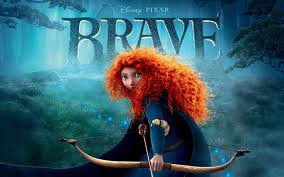 What do you get when you mix a rebellious teenage princess, a mother/queen trying to do what’s best for her country and her daughter, talk of a political marriage, a rowdy bunch of men, and magic? Well, frankly, you get trouble, but you also get Pixar’s newest movie, Brave. After months of anticipation, hanging on the hope that this new princess tale would present audiences with a strong princess fit for modern times, does it pass the test?
What do you get when you mix a rebellious teenage princess, a mother/queen trying to do what’s best for her country and her daughter, talk of a political marriage, a rowdy bunch of men, and magic? Well, frankly, you get trouble, but you also get Pixar’s newest movie, Brave. After months of anticipation, hanging on the hope that this new princess tale would present audiences with a strong princess fit for modern times, does it pass the test?
Brave is set in Scotland in what appears to be the medieval ages. Merida is a headstrong princess who would like nothing better than to practice her fine archery skills and ride her horse through the forest in search of adventure. But life as a princess isn’t so free; princesses have obligations to their family and people. Her mother, Queen Elinor, knows this and has been careful in trying to teach Merida to uphold those obligations, starting by just getting her to behave like a proper princess. Though mother and daughter haven’t seen eye-to-eye on these matters, life has gone on peacefully — until it’s announced that Merida must now fulfill her duty to marry someone she’s never met for political reasons. Unable to convince her mother against the idea, she takes things into her own hands and sets out to change her fate. But will she bring ruin to her kingdom by fighting tradition?
When I first heard the plot for Brave, I was instantly hooked. With a heroine who is not only shown to be skilled in archery fighting against customs and a plot line sporting phrases about changing her fate Before this story really took off, I couldn’t help but think that this could be something similar to Disney’s Mulan. But the movie surprised me in more than one way.

Walt Disney Pictures/Pixar Animation Studios
As you may or may not have picked up on from the plot introduction, Merida and her mother are at odds. Truth be told, my heart sank a bit at the beginning of the film because of this. “Is this going to be another one of those stories where a mother and daughter butt heads?” I wondered. After all, fiction has had a habit of throwing bad mother-daughter relationships in our faces a lot. Yes, moms and daughters may not always see eye-to-eye and some–maybe many–butt heads frequently, but do all the mother-daughter relationships in fiction have to be like that? We see lots of nice father-son relationships in fiction after all. Heck, often moms aren’t even a crucial part of fictional stories. So, when a mom character is actually present, does she always have to be shown as some annoying nag?
That’s why I was extremely happy when it became clear that the minds behind Brave had different ideas for this mother-daughter pair. In fact, although Brave sounds like an epic fantasy from a brief overview, at its heart, this movie is actually about the relationship between Merida and her mother. The dynamic between the two starts off looking stereotypical, but, unlike other stories with this set up, explores the relationship further. While I think we can all understand Merida’s wish to be free, she goes a little too far and forgets her responsibilities to others and how her actions affect them. Queen Elinor, on the other hand, is so focused on the customs and the responsibilities to be flexible and see freer alternatives. Thus bring me to my first surprise; there’s magic and a little action, but Brave is more a journey of Merida and Elinor coming to understand each other rather than a journey filled with fights and mortal danger.
Elinor and Merida are great female characters outside of this mother-daughter relationship story as well. As is evident from the basic storyline, Merida is a whole different kind of princess than the classics. She’s bursting with energy and independence, making her Disney princess predecessors pale in comparison. Queen Elinor is a levelheaded, well-spoken ruler who commands just as much (or more) respect from her subjects as her husband the king. Together the two make a powerful duo of independent women. And isn’t it nice to see a romance-free Disney princess movie for once?
So what’s the other surprise of Brave? While the basic story sounds epic, it’s actually on the lighter side as plots go. Pixar lightens the mood with a witch who runs a woodcarving business, magic that turns people into bears, and clansmen–er, actually the men in general–who largely act as comic relief. To some older fans who are familiar with Pixar’s work, this may be a bit disappointing. Some reviewers are saying this lighthearted feel is not up to the deeper stories of past Pixar films. I don’t follow Pixar’s work so I can’t compare that too much, but I will admit that the movie felt lighter than Pixar’s Up and Disney’s Mulan and The Lion King for some examples. Despite expecting something more epic myself, this didn’t keep me from enjoying Brave.
In the end, like its heroine, Brave breaks the traditions. Everything that defines classic princess movies like Cinderella and Snow White are thrown out the door to give way to a fun fantasy with female characters, relationships, and messages that get both thumbs up. Regardless of whether you’re six or sixty, if you’re interested in any of that, go see Brave.









